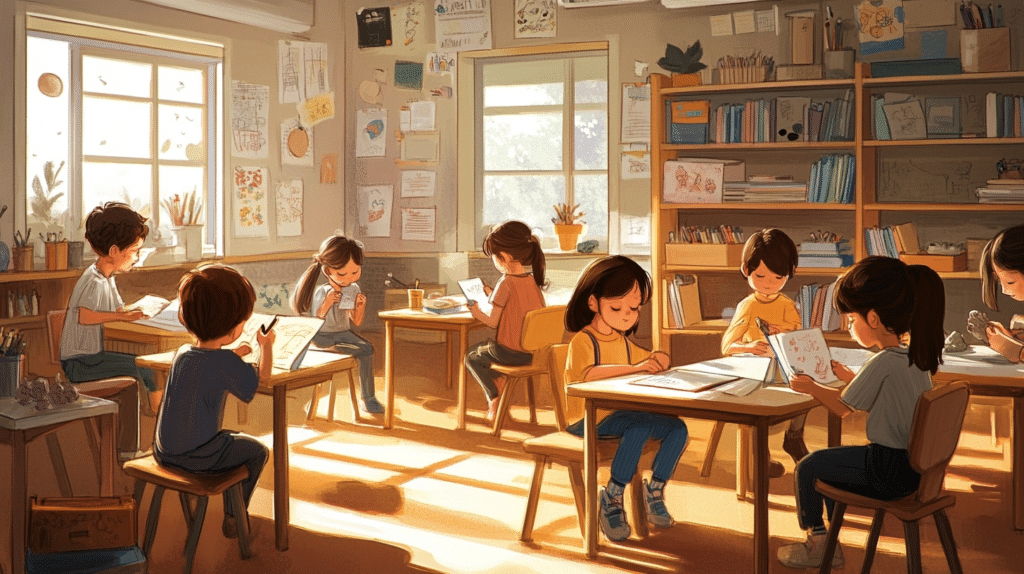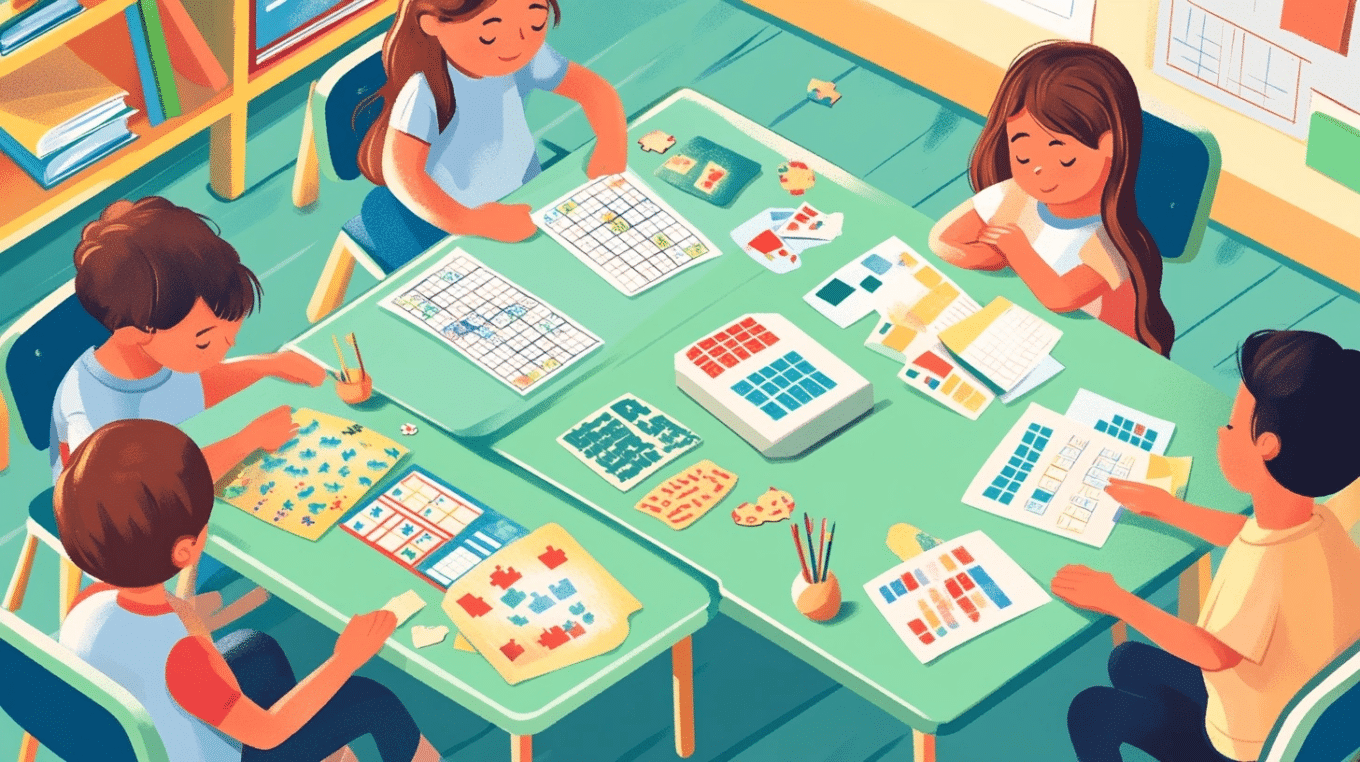Got noisy kids?
Teachers face this challenge daily, trying to keep children engaged without the room turning into chaos. When the noise level rises, learning falls.
Kids become distracted, and you feel the stress building as you try to regain control.
Quiet games can change your classroom. These activities help students focus their energy in positive ways while keeping the volume down. They promote learning, build social skills, and create calm moments during busy school days.
In this blog post, I’ll share 47 quiet games for classroom that work for various age groups. These simple activities need minimal setup and can fill those tricky transition times or serve as valuable learning tools.
Why Are Quiet Games for Classroom Effective?

Quiet games offer solutions to many classroom challenges. They help teachers manage noise levels while keeping students engaged and learning. These activities create balance in the school day, giving kids chances to focus their energy in productive ways.
When students play quiet games, they practice important skills like self-control, patience, and following directions. These activities work well for transition times between lessons or when energy levels need adjusting without causing disruption.
Quiet games also build community. Students learn to work together without shouting or pushing. They communicate in different ways and respect others’ space and thinking time.
Research shows that calm, focused activities improve concentration and memory.
Students often remember content better when they learn it through play rather than traditional instruction. Plus, these games give teachers valuable assessment opportunities to observe students’ understanding and skills.
Movement-Based Quiet Games for Classroom

Kids need to move, but that doesn’t mean the classroom has to be loud!
These activities let students stretch their legs and use their energy while staying relatively quiet. They’re perfect for those times when the class needs a physical break without creating chaos.
Try these games when you notice fidgeting or after long periods of sitting.
1. Silent Ball
Students toss a soft ball around the classroom without speaking. If a student drops the ball, makes noise, or throws poorly, they sit down.
The last student standing wins. This game promotes focus, eye-hand coordination, and helps kids learn classmates’ names.
- Time required: 5-10 minutes
- Materials: Soft foam ball or stuffed animal
- Best for: Grades 2-6
- Setup: Students stand at their desks or in a circle
2. Heads Down, Thumbs Up
Select a few students to be “it.” Others put their heads down with their thumbs up. The chosen students each tap someone’s thumb, then return to their spots. Tapped students guess who tapped them. Great for building observation skills.
- Time required: 10-15 minutes
- Materials: None
- Best for: Grades K-4
- Setup: Students seated at desks
3. Freeze Dance (with music cues only)
Students dance while music plays. When the music stops, everyone freezes in position. Those who move are out. This game helps develop listening skills and body control while allowing movement within a structured format.
- Time required: 5-10 minutes
- Materials: Music player with volume control
- Best for: All grades
- Setup: Clear space for movement
4. Pass the Object
Students pass a small object around a circle while soft music plays. When music stops, the student holding the object answers a question or completes a task. This game builds anticipation while practicing calm, careful movements.
- Time required: 10-15 minutes
- Materials: Small object, music player
- Best for: Grades K-5
- Setup: Students in circle formation
5. Paper Airplane Distance
Students create paper airplanes and take turns throwing them to see whose flies farthest. Measurements can be taken with rulers or tape measures. This combines science learning with fine motor skills practice.
- Time required: 15-20 minutes
- Materials: Paper, measuring tape
- Best for: Grades 2-6
- Setup: Clear runway space in classroom
6. Mirror Movement
Students pair up facing each other. One leads slow, deliberate movements while the partner mirrors them exactly. Switch roles after one minute. This activity teaches focus, observation, and controlled movement.
- Time required: 5-10 minutes
- Materials: None
- Best for: All grades
- Setup: Pairs standing with arm’s length between them
7. Classroom Scavenger Hunt
Give students written lists of items to find in the classroom. They silently search and check off items as they locate them. This encourages reading comprehension and careful observation of the learning environment.
- Time required: 10-15 minutes
- Materials: Scavenger hunt lists, pencils
- Best for: Grades 1-5
- Setup: Prepared lists of classroom items
8. Build with Blocks
Challenge students to build specific structures using blocks without talking. They can work individually or in small groups. This promotes problem-solving, spatial awareness, and non-verbal communication skills.
- Time required: 15-20 minutes
- Materials: Building blocks (LEGO, wooden blocks, etc.)
- Best for: All grades
- Setup: Blocks distributed to individuals or groups
9. Quiet Charades
Students act out words or phrases without making sounds while others guess. Topics can relate to current curriculum. This game builds confidence in non-verbal expression and improves vocabulary recognition.
- Time required: 15-20 minutes
- Materials: Word cards
- Best for: Grades 2-6
- Setup: Prepare word cards with age-appropriate terms
10. Number Line Race
Place a number line on the floor. Students take turns moving from zero to a target number following specific rules (hop, skip, etc.). This combines math concepts with controlled physical movement.
- Time required: 10-15 minutes
- Materials: Tape for number line, number cards
- Best for: Grades K-3
- Setup: Number line taped to floor
Brain-Boosting Quiet Games for Classroom

These mental workouts keep minds sharp while keeping voices soft.
The following games help students practice critical thinking, problem-solving, and content knowledge without raising the noise level.
11. Telephone (Whisper Game)
Students sit in a circle, passing a whispered message from person to person. The final student reads the message aloud to compare it with the original. This teaches careful listening and speaking skills while showing how information changes.
12. I Spy
One student chooses an object in the room and says, “I spy something that…” giving a clue about its color or features. Classmates raise their hands to guess. The correct guesser becomes the next spy.
13. Pictionary (no talking)
Students draw images representing words or concepts while teammates guess what they’re drawing. No verbal clues are allowed. This game strengthens visual communication and builds vocabulary through fun visual connections.
14. Match the Shadow
Display cards showing objects with their shadows mixed up. Students match objects to their correct shadows. This enhances visual discrimination skills and teaches about light and shadow concepts in science.
15. Memory Card Game
Cards are placed face down. Students take turns flipping two cards, trying to find matching pairs. If no match, cards are turned back over. This classic game builds concentration and visual memory.
16. Puzzle Race
Break students into small groups. Each group receives the same puzzle to complete. The first group to finish wins. This fosters teamwork, spatial reasoning, and problem-solving in a collaborative setting.
17. Shape Sort Challenge
Students sort geometric shapes by specific attributes like sides, angles, or size. This can be done individually or as a team. The activity reinforces math concepts while practicing classification skills.
18. Word Search
Students find hidden words in a grid of letters. Words can relate to current curriculum topics. This activity enhances pattern recognition, spelling awareness, and visual scanning skills in a quiet, focused format.
19. Crossword Puzzle
Students complete age-appropriate crossword puzzles related to vocabulary or content areas. Clues can be definitions, synonyms, or content questions. This builds word knowledge and spelling in an engaging format.
20. Spot the Difference
Show students two similar pictures with subtle differences. They must identify all differences. This sharpens observation skills and attention to detail while providing a calm, focused activity.
21. Count the Objects
Show an image with many items. Students count specific objects within the picture. This builds number sense and teaches systematic counting strategies while encouraging careful visual attention.
22. Flashcard Match
Students match questions with answers using flashcards. Topics can include math facts, vocabulary words, or science concepts. This reinforces learning through visual recognition and association.
23. Picture Bingo
Create bingo cards with images instead of numbers. Call out item names for students to mark on their cards. This combines listening skills with visual recognition in a structured, engaging format.
24. Tic Tac Toe Tournament
Students play tic-tac-toe against different classmates in tournament style. Winners advance to play other winners. This teaches strategy, turn-taking, and friendly competition in a familiar game format.
25. Match the Emotion
Students match emotion words with facial expression pictures. This builds emotional intelligence and vocabulary for feelings while creating opportunities to discuss appropriate emotional responses.
26. Number Grid Challenge
Give students number grids with some numbers missing. They fill in blanks following patterns or rules. This builds number sequence understanding and pattern recognition for mathematical thinking.
27. Alphabet Order Race
Students arrange letter cards or word cards in alphabetical order. This can be done individually or in small groups. The activity reinforces alphabetizing skills essential for dictionary and reference use.
28. Dot-to-Dot Race
Provide dot-to-dot puzzles where students connect numbered dots to create images. This combines number sequence knowledge with fine motor control in a satisfying activity with a visual reward.
29. What’s Missing?
Show students items on a tray, then cover and remove one item. Students identify what’s missing. This builds visual memory and attention to detail through an engaging, game-based challenge.
30. Secret Code Writing
Students write messages using simple substitution codes where letters are replaced by symbols. Classmates decode each other’s messages. This builds pattern recognition and logical thinking skills.
31. Shape Building with Tangrams
Students use tangram pieces to create specific shapes or solve tangram puzzles. This ancient Chinese puzzle game builds spatial reasoning and geometric understanding through hands-on exploration.
32. Roll and Graph
Students roll the dice and record the results on graph paper, creating bar graphs of outcomes. This combines probability concepts with data visualization in an active but quiet math-focused game.
33. Whisper Count
Students count by whispers, passing numbers around the circle. Each student adds the next number in the sequence. Miss a number, and the count starts over. This builds number sequence knowledge and listening skills.
34. Picture Story Sequencing
Give students picture cards showing story events out of order. They arrange cards to show the correct sequence. This builds narrative understanding and logical thinking about cause and effect relationships.
35. Hand Signal Quiz
Ask questions where students respond using hand signals instead of speaking. Signals might show multiple-choice options or true/false responses. This allows whole-class assessment while maintaining quiet.
36. Hidden Words Puzzle
Students find smaller words hidden within larger words. For example, “classroom” contains “class,” “room,” “ass,” etc. This builds word analysis skills and vocabulary awareness through word play.
Creative and Calming Quiet Games for Classroom

Sometimes, the class needs to slow down and reset. These activities help students find their center while still engaging their minds.
Use these games after lunch, during rainy day recesses, or anytime you need to bring the energy level down while keeping students happily occupied.
37. Mindful Breathing Challenge
Students practice controlled breathing, focusing on the sensations. They might count breaths or visualize air moving through their bodies. This teaches self-regulation and stress management through mindfulness practice.
38. Quiet Coloring
Provide coloring sheets related to curriculum topics. Students color quietly, focusing on neat work and color choices. This calming activity improves fine motor control while reinforcing content through visual means.
39. Mystery Drawing
Describe an image step by step while students draw what they hear. Compare final drawings with the original image. This builds listening comprehension and following sequential instructions in a creative format.
40. Write the Room
Students move quietly around the classroom with clipboards, recording words they find on walls, charts, and displays. This combines movement with literacy practice in an engaging word-hunt activity.
41. Silent Simon Says
Play Simon Says using only visual cues—no verbal commands. Students must watch carefully to follow along. This builds visual attention and self-control while allowing controlled movement in the classroom.
42. Silent Reading Relay
Students read a short passage silently, then pass to the next student who continues reading. At the end, students answer questions about the text. This builds reading fluency and comprehension.
43. Hidden Object Hunt
Hide small objects around the classroom. Students search quietly, keeping found objects secret until the hunt ends. This combines careful observation with self-control in an exciting but controlled activity.
44. Silent Story Building
Students pass the paper around the circle. Each adds one sentence to create a story. No talking allowed during writing. The final story is read aloud. This builds creative writing skills and narrative structure.
45. Clay Sculpting Challenge
Give students clay or play dough to create objects related to current topics. This tactile activity allows artistic expression while building fine motor skills and concept visualization in a naturally quiet format.
46. Trace the Picture
Provide transparent paper for students to trace images related to the curriculum. This improves fine motor control and visual perception while creating art connected to classroom learning in a focused activity.
47. Classroom Maze
Create a simple maze on the floor with tape. Students navigate through without touching lines or making noise. This builds spatial awareness and controlled movement in an engaging challenge format.
Final Thought
Quiet doesn’t mean boring! These 47 quiet games for classroom show how learning can happen in a calm, focused setting. You’ve now got tools for those moments when class energy needs shifting without losing teaching time.
Remember, the best classroom management happens before problems start. Having these games ready helps you respond quickly when noise levels rise or attention wanders.
Try adding one or two games to your routine this week. Notice which ones your students love, then expand your collection. Want to share your success stories? Leave a comment below about your favorite quiet classroom game.
Ready for a quieter, more productive classroom? The games are in your hands now!




